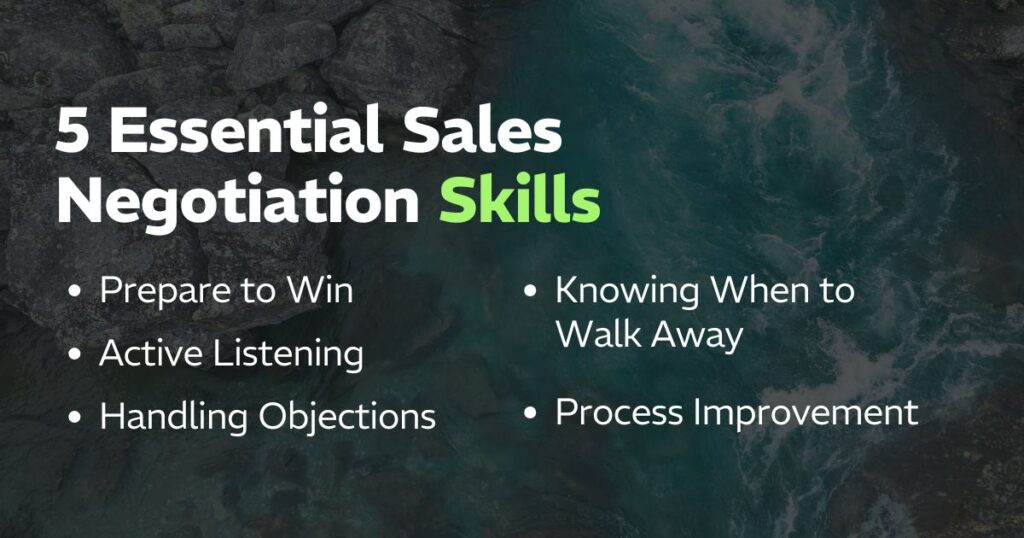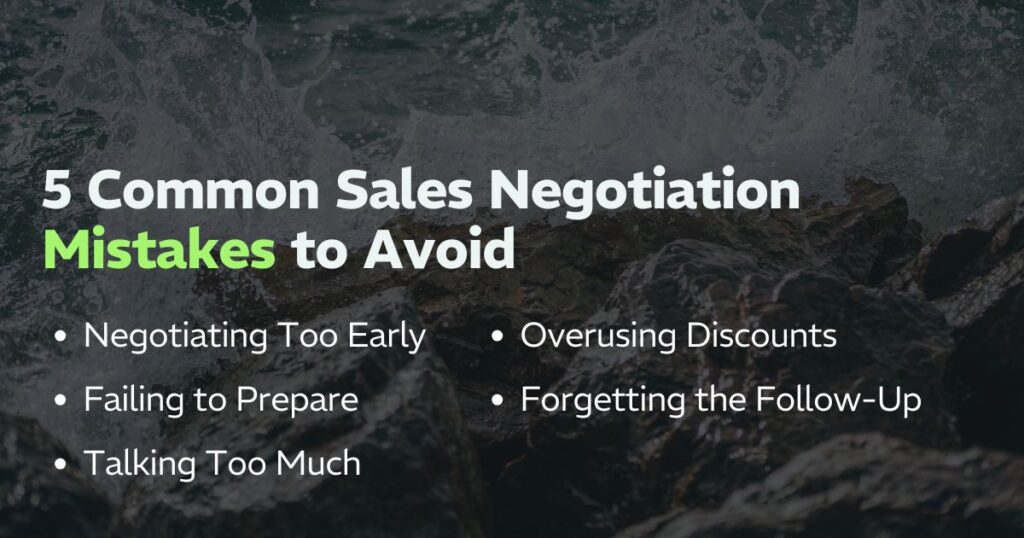Sales negotiation isn’t just about pushing for better terms. It’s about building trust, solving problems, and creating a mutually beneficial outcome that serves both sides of the table.
The best sales reps don’t wing it or fall back on discounts when it’s time to talk numbers. They rely on battle-tested sales negotiation strategies that are rooted in psychology, emotional intelligence, and experience. They know how to negotiate effectively, guide the sales process, and close deals with confidence.
Let’s break down the negotiation strategies that help sales teams lead meaningful conversations at the negotiating table and walk away with a win that lasts beyond the signature.
What Is Sales Negotiation? The Psychology Behind It
At its core, sales negotiation is a collaborative conversation between buyers and sellers aimed at reaching a deal. But it’s not just about getting to “yes.” It’s about exchanging value and solving pain points in a way that drives long-term partnerships.
Great negotiators don’t give value away—they create it. They understand what drives decision-making, and they shape their conversations around it. That starts with mastering the human side of the negotiation process.
Buyer behavior is rooted in a mix of logic and emotion. People buy with their hearts and justify with their heads. That’s why emotional intelligence is essential. The best sales reps learn to read the room, gauge tension, and shift gears in real time.
And here’s where anchoring becomes powerful: when you set the first number, you frame the entire discussion. You guide how your product or service is perceived. That initial price? It’s more than a number. It’s a narrative.
Essential Sales Negotiation Skills
Before you ever sit down to talk terms, you need to sharpen the core competencies that lead to meaningful impact. These foundational skills separate good salespeople from great ones.
Prepare to Win
Sales preparation is your power move. The more you know before a negotiation starts, the more control you’ll have when it counts. Know who’s in the room. Understand the decision-maker’s role, the company’s strategic priorities, and the true pain points that your solution can solve.
Dig deeper than surface-level intel. Research recent news, funding rounds, or leadership changes. Know their alternatives. Be ready to speak their language and map your product or service to their world. Preparation builds confidence, and confidence closes.
Active Listening
Don’t just listen. Make them feel heard.
Too many sales reps focus on what they’re going to say next instead of absorbing what the buyer is actually telling them. Active listening isn’t passive; it’s a strategic tool. Reflect what you hear. Ask clarifying questions. Reframe their concerns in your response.
When people feel understood, they start to trust you. And trust is what moves negotiations from transactional to transformational.
Handling Objections
Objections aren’t the end of the deal. They’re the beginning of understanding.
Resistance is normal. Expect it. But the way you handle it determines whether the conversation stalls or accelerates. Instead of reacting defensively, dig into what’s behind the concern. Often, objections are signals of interest, not disinterest. They mean the buyer is engaged; they’re just not sold yet.
Top negotiators are ready for pushback. They stay composed, validate the concern, and pivot to proof. Handling objections smoothly is what sets pros apart at the negotiating table.
Knowing When to Walk Away
Not every deal is the right deal—and that’s OK.
One of the most overlooked negotiation strategies is knowing when to politely exit. If the terms don’t align with your value, if the deal threatens your margins, or if red flags keep popping up, be willing to walk.
Walking away isn’t a weakness. It’s discipline. It signals that you stand behind the value of what you’re offering. And paradoxically, it can bring the buyer back to the table with renewed urgency and respect.
Process Improvement
Your sales process is your feedback loop. Use it.
Every deal, win or lose, teaches you something. Were you too quick to negotiate? Did you miss a key stakeholder? Did you handle the objection well or could you have framed the value better?
Build regular reflection into your team’s sales process. Debrief after major conversations. Look for patterns. Share insights. That kind of discipline compounds over time and improves sales team performance.

8 Sales Negotiation Strategies
Let’s dive into the sales negotiation tactics top performers use every day. These aren’t theoretical strategies and tactics. They’re tested in the real world and built for results.
Give-and-Take
Every negotiation involves some give, but you need to give with intention. Trade wisely. Instead of discounting, offer value-adds or service enhancements that protect your margin and elevate the offer.
Try this: “If we include [X feature], can you commit to [Y timeline]?”
The Silence Technique
Silence can feel uncomfortable, which is exactly why it works. A well-timed pause forces the other party to fill the space, often revealing critical insights.
Try this: Ask your price, then wait. Just…wait.
The “Feel-Felt-Found” Method
This is one of the oldest negotiation strategies out there.
Try this: “I understand how you feel. Other clients have felt the same way, but they found that once they started using our solution, results followed quickly.”
The Value Justification Strategy
Stop selling price. Start selling ROI.
Try this: “I understand budget is a concern. But when you consider the impact on your team’s productivity and revenue, this isn’t a cost, it’s an investment.”
The Time Pressure Close
Urgency moves people. But it has to be authentic.
Try this: “This pricing is valid through Friday. Should we lock it in now so you don’t miss the window?”
When done right, this creates a natural nudge, not a hard sell.
Multiple Options
When people have choices, they feel in control. Offering two or three packages guides decision-making without overwhelming.
Try this: “Would you prefer to start with our standard plan at $X, or go with the premium package at $Y for additional support?”
The ‘Flinch’ Reaction
Sometimes a visible reaction to a lowball offer resets the entire tone.
Try this: “Wow, that’s quite a bit below our standard rate. How did you land on that number?”
This simple negotiation tactic can make the other party re-evaluate their position instantly.
The ‘Limited Authority’ Tactic
This move gives you breathing room and leverage.
Try this: “I’d love to move forward with that, but I’ll need to run it by our leadership team first.”
Delaying the decision subtly shifts the power dynamic, giving you more control over the conversation.
Common Sales Negotiation Mistakes to Avoid
Even experienced sales reps can fall into traps that weaken their position at the negotiating table. Awareness is half the battle. Here are a few common missteps that can sabotage your ability to negotiate effectively and close the deal:
Negotiating Too Early
Jumping into price talk before you’ve clearly established value is a classic mistake. When you lead with a number, you lose the chance to shape the buyer’s perception of your product or service.
Pro tip: Anchor the conversation in outcomes, not outputs. Let the ROI do the heavy lifting.
Failing to Prepare
The best sales negotiation tactics are only as good as your sales preparation work. Know who’s at the table, what matters to them, and where your leverage lies.
Ask yourself:
- What’s their alternative to a negotiated agreement?
- What’s mine?
- What does success look like for both sides?
Talking Too Much
Silence is a strategic tool. A pause gives space for your buyer to process, ask questions, or even reveal what really matters to them.
It’s not about having the perfect pitch. It’s about having the discipline to listen.
Overusing Discounts
Discounting might seem like a quick way to win, but it often signals desperation. Instead of giving something away, offer something additional that enhances perceived value.
Real-world advice: Sell solutions, not price points.
Forgetting the Follow-Up
Strong follow-up isn’t just a courtesy; it’s a continuation of the negotiation process. Recap key points. Reaffirm next steps. Keep the momentum moving forward.
Closing a deal doesn’t always happen in the room. It often happens in the follow-through.

How to Master Sales Negotiation and Win More Deals
Effective sales negotiation isn’t about slick lines or flashy charts. It’s about solving real problems, staying composed, and focusing on outcomes that last.
The best negotiators:
- Sell value, not just price.
- Know how to defuse tension while handling objections.
- Prepare like pros and stay patient under pressure.
- Build rapport through empathy, not ego.
- Understand that sometimes the best alternative to a negotiated agreement is walking away..
Whether you’re managing an enterprise account or coaching sales teams, investing in sales negotiation training can transform your results. It’s how you go from discounting deals to closing a deal that moves the business forward.Want to sharpen your sales negotiation skills? Book Ryan Estis for a sales keynote today.





![[RYAN] Featured Image - Effective Pre-Call Planning for Sales Success [RYAN] Featured Image - Effective Pre-Call Planning for Sales Success](https://ryanestis.com/wp-content/uploads/bb-plugin/cache/RYAN-Featured-Image-Effective-Pre-Call-Planning-for-Sales-Success-1024x683-panorama-5450085f2a20c8468e6be608dffdca5c-.jpg)
![[RYAN] Featured Image - Effective Sales Training Image of Mountain in the background](https://ryanestis.com/wp-content/uploads/bb-plugin/cache/RYAN-Featured-Image-Effective-Sales-Training-1024x538-panorama-675783a5b1248eec528a45c7f36d5e73-.png)



